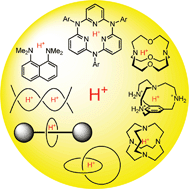Proton complexation differs from simple protonation by the fact that the coordinated hydrogen atom is bound intramolecularly to more than one donor atom. This is usually achieved by covalent bonding supplemented by hydrogen bonding. In a few cases, however, the complexed proton is hydrogen-bound to all donor atoms, which gives rise to single well (SWHB) and low barrier (LBHB) hydrogen bonds. This tutorial review highlights a full range of proton complexes formed with chelating and “proton-sponge”-type ligands, cryptand-like macropolycycles, and molecules of topological relevance, such as rotaxanes and catenanes. The concept of proton complexation can explain how the smallest cation possible can bring molecules to order and trigger intramolecular molecular rearrangements and motions.
